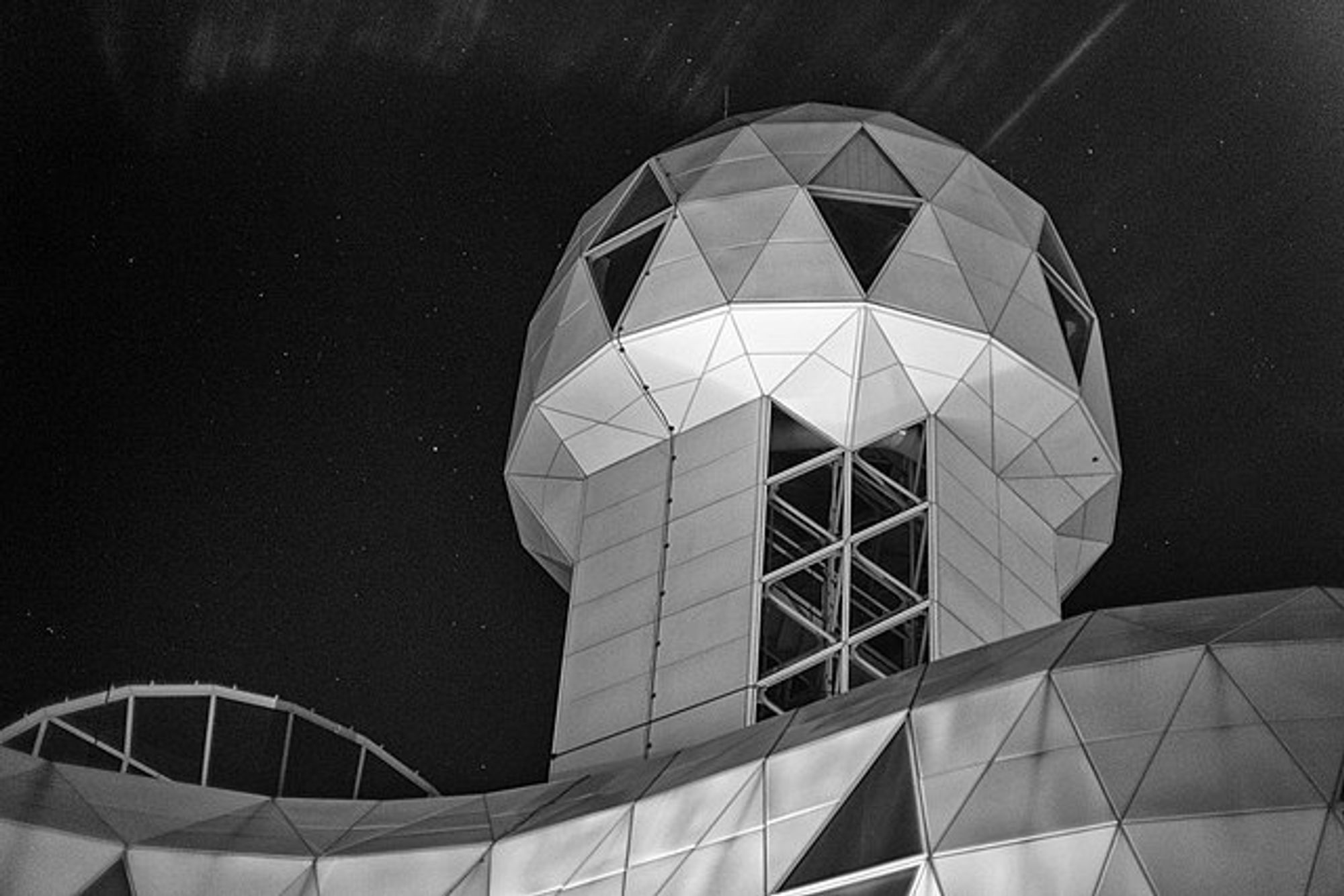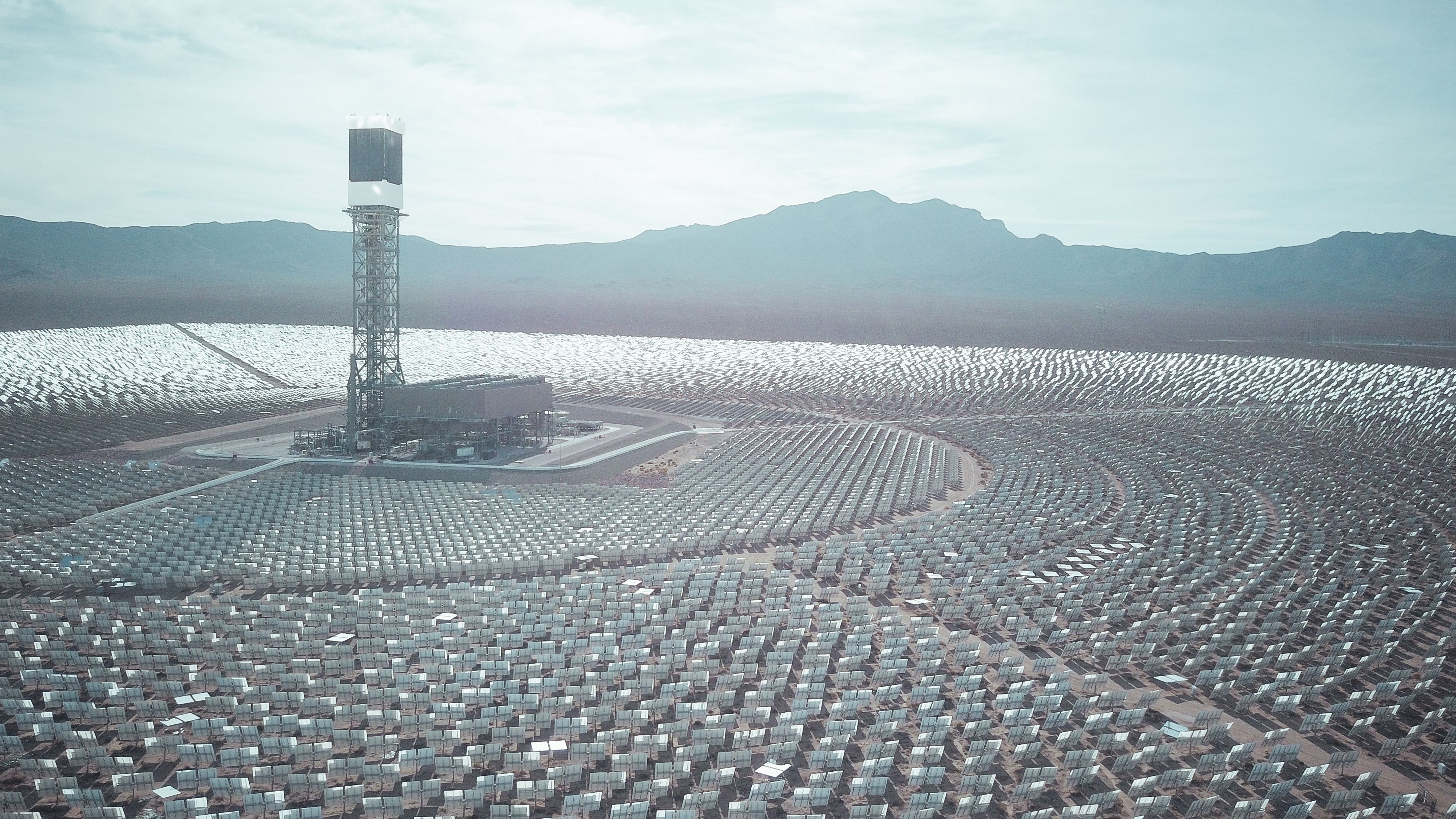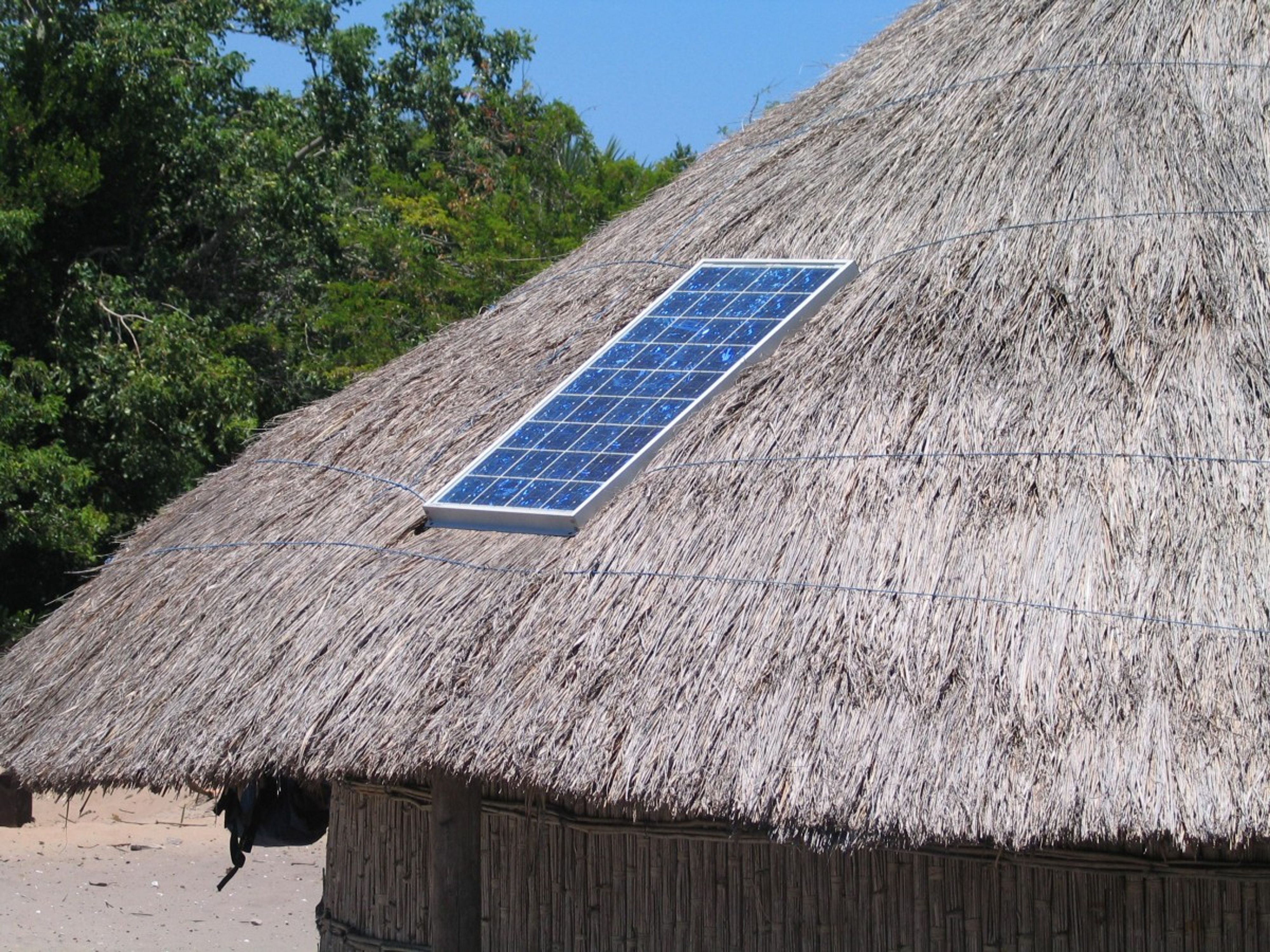
Biosphere 2 in 2022. Image by Christopher Michel. Courtesy Creative Commons.

Crescent Dunes Solar Energy Project. Image by Kindel Media. Courtesy Kindel Media.
In 2016, Tesla CEO Elon Musk unveiled his company’s Solar Roof on the former Desperate Housewives set, promising his photovoltaic-shingle system would revolutionize the sustainable-energy industry. It was 37 years after Jimmy Carter installed solar panels on the White House roof (removed only a few years later by the Reagan administration). But while President Carter’s largely symbolic gesture was intended to kick a crippling dependence on foreign oil, Musk instead spoke to 21st-century anxieties, namely the existential threat posed by climate change. The painstakingly suburban aesthetics of Tesla’s tiles suggested, for once, that an actionable response to the planetary crisis could look and feel like the status quo and not some radical departure from first-world comforts. Except that the model homes of Wisteria Lane were outfitted in dummy roofs, because the product wasn’t ready yet; plagued by delays, disorganization, and low consumer demand, it never became the breakthrough technology once prophesied. Investor John Engle argues that for years Musk has “sustained a kind of Kabuki theater in which the Solar Roof ramp is always imminent, but never here.”
The social diffusion of solar power has come in the age of post-truth politics and celebrity spectacle. While America’s climate-change-denier-in-chief has dismissed renewables as “an expensive way of making tree huggers feel good about themselves,” Musk, the nation’s most outlandish CEO, continues to bolster his post-carbon empire, even if Tesla’s acquisition of the solar-energy corporation SolarCity has resulted in mountains of debt and profit shortfalls. The Tesla group has failed to deliver on 5,000 solar-related jobs at a new taxpayer-funded factory in Buffalo, New York, Walmart sued and has since settled with Tesla over solar panels on store roofs that allegedly caught fire, and California homeowner Kevin Pereau claimed he put down 2,000 dollars for a solar roof more than two years ago and never heard from the company again — only getting his deposit back after tweeting at Musk every day.

Crescent Dunes Solar Energy Project. Image by Marygrikas. Courtesy Creative Commons.
Tariffs on foreign-made solar products are intended to benefit American manufacturers like Tesla. Though Trump’s taken more heat for it, the penalties actually date back to the Obama administration. (Obama only targeted China while Trump’s tariffs apply to all Asian manufacturers, affecting Malaysia and South Korea who dominated solar-panel imports to the U.S. in 2017.) In June 2020 as Trump’s trade war with China was making headlines, the White House introduced a loophole that actually makes the import of two-sided panels tariff-free. Speculation that their products could soon flood the U.S. market with a little maneuvering, out-competing States-based solar-panel manufacturers like Tesla, have since played out. Whereas the United States shipped just 1% of solar panels and cells in 2020, China shipped 62% of them.
While Musk’s solar business has failed to flourish even during this protectionist period (potentially now in its twilight), Obama-era tariffs have made the fortune of another celebrity entrepreneur, the Senegalese-American recording artist turned Afrofuturist mogul Akon. A decade ago, motivated to bring electricity to his grandmother’s rural village, Akon explored the possibility of extending the energy grid, which in Senegal relies predominantly on heavy fuel oil. While Akon allegedly secured investment from the oil industry to expand the grid, Senegalese President Abdoulaye Wade warned of potential geopolitical conflicts that could be triggered. Akon then looked to solar as a less-threatening alternative, discovering that, thanks to Obama’s tariffs, there was a surplus of Chinese-made panels intended for the U.S. market. He secured a billion-dollar credit line through a Chinese conglomerate and, in 2014, founded the for-profit Akon Lighting Africa. “Being an entertainer, being popular worldwide,” Akon told CNBC, “does give you an advantage to meet some very powerful people.”

Solar panel attached to a thatched roof. Courtesy Creative Commons.
Starting with a pilot project in rural Senegal, Akon Lighting Africa has brought solar electricity to a million households across 16 countries, including Benin, Guinea, Mali, Niger, and Sierra Leone. Riding the success of this energy project, Akon is currently in the process of expanding his forward-looking empire, all the while still making new music — he released his fifth studio album Akonda in 2019. He’s announced (but not yet launched) a cryptocurrency called “Akoin,” and finalized an agreement with the Senegalese government for Akon City, a solar-powered eco-tourism destination outside Dakar where all-transactional activity will be conducted in Akoin. The late-Hadid-esque buildings shown in renderings of Akon City are credited to Dubai-based architect Hussein Bakri of BAD Consulting, with Sana'a-based engineering firm Yemeni Group listed as another project partner. Akon has teased that it will be “a real life Wakanda.”
Akon is emerging as a foil to Musk, an alternative celebrity entrepreneur positioning himself as a mascot of utopian tomorrow. There’s a symmetry to their contrasts — one was born in America but is today based in Africa, the other was born in Africa but is now based in America; one is entirely self-made, the other had a headstart through inherited wealth; one built his name through music then leveraged his celebrity to enter the world of business, the other leveraged his status as an entrepreneur known for sci-fi propositions to enter the world of pop culture, releasing his first song this year (yes, Musk even performs the vocals on the EDM track “Don’t Doubt ur Vibe”). For both men, solar power is a vital part of their futurist business portfolios. That’s to some extent just economics — renewables are one of the world’s fastest-growing industries — but solar also has imaginary potential, inspiring an idealistic but imaginable tomorrow. Case in point: while there’s no windpunk movement, solarpunk has emerged in response to the climate crisis as an actionable-alternatives genre whose utopian visuals span WOHA-esque green-terraced towers and Art Nouveau-style stained-glass solar panels.

Akon and a mock up of Diamniadio Lake City in Senegal. Courtesy Getty Images, Hussein Bakri, BAD Consultant, Semer Group.
Musk’s sci-fi imperialism and Akon’s Afrofuturism are both informed by the ideology of “green growth” — the illusion that our capitalist economies can continue to expand without limits as long as we “techno-fix” our way out of the current crisis by swapping dirty fossil fuels for renewable energy and environmentally-friendly technologies. It’s an ideology that’s informed master-planned “eco-city” projects like Masdar City in the United Arab Emirates, led by Foster + Partners, and Sejong City in South Korea, funded in large part by tech giant Samsung. It’s paradoxical to think that the solution to waste, pollution, and diminishing resources is yet more building. Ditto that Musk could be considered some sort of environmental savior when, in 2018 alone, he flew 150,000 miles in his private jet, producing carbon emissions 263 times greater than those of the average inhabitant of planet Earth. Still, celebrity-led green growth is lauded by the current socioeconomic order because it’s not as threatening to the status quo as more radical propositions like degrowth. A headline about a pop star’s new eco-city in West Africa is going to get more clicks than one about a little-known socialist academic saying we need to use fewer resources.
Weirdly, there’s a shared origin point for both futuristic eco-experiments and contemporary celebrity culture: Biosphere 2. Developments like Masdar City are often compared to this 3 acre closed-environment lab that was built in the 1990s in the Arizona desert town of Oracle. The Biosphere project sealed eight people inside a complex of glass pyramids and geodesic domes to test the livability of a closed ecological system. (Steve Bannon, bizarrely, was an executive). The hope was for Biosphere to make space colonization possible, but group dynamics between the feuding participants and the resulting press coverage of their isolated life under the bubble became a new formula for entertainment.Biosphere-inspired Big Brother, whose original season aired in the Netherlands in 1999, then launched an entirely new small-screen genre, reality TV, which in turn spawned a new type of celebrity. Trump leveraged his notoriety from The Apprentice to run for president. Kylie Jenner turned her fame from Keeping Up with the Kardashians into a direct-to-consumer cosmetics business, becoming the youngest ever billionaire. In our attention-economy era, a flattening of celebrity has occurred that blurs the boundaries between business, politics, and entertainment. This is the landscape in which Musk and Akon enact the new archetype of the entrepreneur, respectively fame-generating and fame-fueled. Is celebrity a renewable resource?

Biosphere 2 in 2022. Image by Christopher Michel. Courtesy Creative Commons.

Black and White, Portfolio, Arizona, Biosphere 2, 2006-2007. Image by GCP Grey. Courtesy Creative Commons.
Romanian mathematician and economist Nicholas Georgescu-Roegen argues that all natural resources are irreversibly degraded when put to use in economic activity. While fossil fuels can be characterized as a stock — a limited cache — and solar as a flow — limited only by the rate it emanates — renewable enthusiasts frequently disregard the energy it takes to produce and maintain the renewable sources themselves, not to mention the inherent obsolescence and waste. There’s a billion-dollar 1,500-acre solar plant outside Las Vegas that sits empty, its technology outdated before it went online. By the end of 2016, we’d already produced 250,000 metric tons of solar-panel waste with 78 million predicted by 2050. Storing solar energy in batteries depends on rare earth metals like lithium, the mining of which has dire consequences like toxic lakes — one in Mongolia has been dubbed “the worst place in the world.” These tragedies shouldn’t be reasons to give up on striving for a lighter or neutral carbon footprint, but are confirmation that we can’t just swap one form of power for another. Thinking solar technologies will save us while ignoring the need to downscale production and consumption is simply flying too close to the sun.